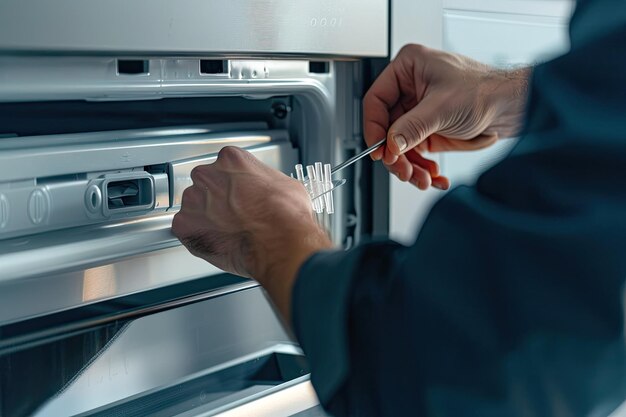Finding the Perfect Balance: Water Levels in Your Refrigerator Drip Pan
When it comes to maintaining your refrigerator, there are several components that require your attention. One often overlooked yet crucial part is the drip pan, and a common query is, "How much water should actually be in there?" Understanding this small but significant detail can help prevent bigger issues down the road. Let’s explore this in detail to ensure your refrigerator stays in top-notch condition.
📥 What is a Refrigerator Drip Pan?
Before diving into how much water should be in the drip pan, it's important to understand its purpose and function. A refrigerator drip pan, also known as a drain pan, is located underneath your refrigerator. It collects water that drips from the evaporator coil and condensation from the defrost cycle. This helps in safeguarding your kitchen floor from water damage while ensuring the appliance runs smoothly.
Purpose and Function
- Condensation Collection: The primary purpose is to collect condensation that builds up within the refrigerator.
- Assist in Evaporation: It holds the water until it evaporates, aided by the heat generated from the refrigerator's compressor.
- Prevent Overflow: Proper function ensures water doesn’t overflow onto your kitchen floor.
🌊 How Much Water is Normal in a Drip Pan?
It’s essential to understand expected water levels to identify potential issues. In normal circumstances, your refrigerator drip pan should only have a minimal amount of water. Periodic checks will reveal whether the water level is typical or indicative of a problem.
Expected Water Levels
During regular operation, the water collected should evaporate before the pan overfills:
- Typical Conditions: A thin layer of water or slight pooling.
- High Humidity Conditions: Slightly more water might be present due to increased condensation.
The water collected usually evaporates before overfilling, but under certain conditions, like high humidity, more may accumulate.
Key Signs of an Issue
Be alert for these signs indicating a problem:
- Consistently Full Pan: This suggests potential issues such as drainage blockages or excessive humidity.
- Foul Odor: Stagnant water can lead to unpleasant smells and should be addressed quickly.
- Water Leaks: Frequent spills beneath your fridge signal a poorly functioning drip pan setup.
🔍 Underlying Causes for Excessive Water Collection
Why might your drip pan be consistently full? Several factors could lead to this, including humidity levels, blocked drainage systems, or malfunctioning components.
Common Culprits
- Humidity: During humid days, more moisture is drawn into the fridge, increasing water collection.
- Blocked Drain Tube: Ice or debris can block the drain tube, causing overflows.
- Faulty Defrost Mechanism: If the defrost cycle is malfunctioning, excess water can accumulate.
- Leaking Door Seals: Inefficient seals can cause temperature fluctuations that impact condensation levels.
🛠️ Addressing Drip Pan Issues
If you notice more water than usual, it's crucial to address the issue promptly to avoid further complications. Here’s how you can tackle this effectively.
Fixing Common Problems
- Clear Drain Blockages: Regularly inspect and clean the drain tube to prevent ice or debris build-up.
- Check Door Seals: Ensure that the door seals are intact and replace them if you spot any wear and tear.
- Review Defrost Cycle Settings: Confirm that defrost settings are correctly configured to avoid unnecessary water accumulation.
💡 Pro Tip: Regularly schedule checks as part of your appliance maintenance routine to keep problems at bay.
🤔 When Should You Seek Professional Help?
While many issues can be fixed with regular maintenance, there are times when professional intervention is required. Knowing when to seek expert help is critical to maintaining your refrigerator.
Indicators for Professional Assistance
- Persistent Water Issues: If problems persist after initial troubleshooting, call a technician for a detailed assessment.
- Unfamiliar Noises: Unusual sounds during operation might indicate underlying mechanical issues needing professional attention.
- Comprehensive Inspection: Routine professional inspections can provide peace of mind and prolong appliance lifespan.
📝 Visual Summary: Quick Tips to Maintain a Dry Drip Pan
Here's a concise checklist to guide you through maintaining an optimal water level in your refrigerator drip pan:
- 🔍 Regular Checks: Periodically inspect the drip pan.
- 🌡️ Manage Humidity: Use dehumidifiers during humid weather to reduce moisture intake.
- 🧹 Clean Drain Tubes: Clear any blockages for unobstructed drainage.
- 🔄 Check Defrost Settings: Ensure the defrost cycle is functioning properly.
- 🚪 Inspect Door Seals: Proper sealing prevents unnecessary water buildup.
The Bigger Picture: Why It's Important
Maintaining the right water level in your drip pan is crucial for several reasons. A well-functioning refrigerator avoids potential water damage, reduces operational noise, and helps in maintaining optimal performance. Paying attention to details such as the drip pan can ultimately save you time and money.
Understanding how much water is normal in a refrigerator drip pan doesn’t just help in solving immediate concerns—it can extend the lifespan of your appliance and keep your home running smoothly. By staying proactive in maintenance and knowing when to call for help, you ensure peace of mind and an efficiently running household.
By addressing these small components, you contribute significantly to the longevity and functionality of your refrigerator, ensuring it serves you well for years to come.
